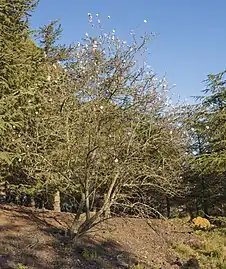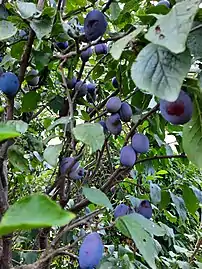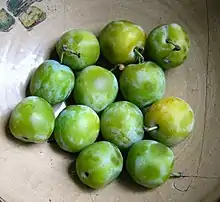| Prunus domestica | |
|---|---|
 | |
| Scientific classification | |
| Kingdom: | Plantae |
| Clade: | Tracheophytes |
| Clade: | Angiosperms |
| Clade: | Eudicots |
| Clade: | Rosids |
| Order: | Rosales |
| Family: | Rosaceae |
| Genus: | Prunus |
| Subgenus: | Prunus subg. Prunus |
| Section: | Prunus sect. Prunus |
| Species: | P. domestica |
| Binomial name | |
| Prunus domestica | |
| Synonyms[1] | |
|
List
| |
Prunus domestica is a species of flowering plant in the family Rosaceae. A deciduous tree, it includes many varieties of the fruit trees known as plums in English, though not all plums belong to this species. The greengages and damsons also belong to subspecies of P. domestica.
Its hybrid parentage was believed to be Prunus spinosa and P. cerasifera;[2][3] however recent cytogenetic evidence seem to implicate 2×, 4×, 6×[lower-alpha 1] P. cerasifera as the sole wild stock from which the cultivated 6× P. domestica could have evolved.[4]
Description

Typically it forms a large shrub or a small tree. It may be somewhat thorny, with white blossom, borne in early spring. The oval or spherical fruit varies in size, but can be up to 8 centimetres (3 inches) across. The pulp is usually sweet,[5] but some varieties are sour. Like all Prunus fruits, it contains a single large seed, usually called a stone, which is discarded when eating.
 A specimen with its first flowers at the end of February
A specimen with its first flowers at the end of February.jpg.webp) Flowers in spring
Flowers in spring Young leaves
Young leaves Unripe fruits
Unripe fruits Ripe fruits
Ripe fruits
Taxonomy


Subspecies
Cullen et al. (1995) recognises three subspecies,[6] though scientific studies favor a more fine-grained separation:
|
The subspecies cross easily, so that numerous intermediate forms can be found: their sweetness and tartness may vary, their colors varying from bluish-purple to red, orange, yellow or light green.
Cultivars

Numerous cultivars have been selected for garden use. The following have gained the Royal Horticultural Society's Award of Garden Merit:
Uses
The pulp is edible[19] and usually sweet, though some varieties are sour and require cooking with sugar to make them palatable.
Plums are grown commercially in orchards, but modern rootstocks, together with self-fertile strains, training and pruning methods, allow single plums to be grown in relatively small spaces. Their early flowering and fruiting means that they require a sheltered spot away from frosts and cold winds.[5]
Most prunes (dried plums) are made from fruits of this species.
Notes
- ↑ Diploid, tetraploid, hexaploid: see Polyploidy
References
- ↑ "The Plant List: A Working List of All Plant Species". Retrieved January 27, 2014.
- ↑ Crane, M.B.; Lawrence, W.J.C. (1947). The Genetics of Garden Plants (PDF). MacMillan & Co. LTD. p. 233. Archived from the original (PDF) on 2017-12-15. Retrieved 2017-06-29.
- ↑ Khanizadeh, S.; Cousineau, J. (2000). Our Plums/Les Pruniers de chez nous. Agriculture and Agri-Food Canada/Agriculteur et Agroalimentaire Canada. ISBN 978-0-660-61568-4.
- ↑ Zohary, Daniel (1992-03-01). "Is the European plum, Prunus domestica L., a P. cerasifera EHRH. × P. spinosa L. allo-polyploid?". Euphytica. 60 (1): 75–77. doi:10.1007/BF00022260. ISSN 0014-2336. S2CID 10923512.
- 1 2 Klein, Carol (2009). Grow Your Own Fruit. United Kingdom: Mitchell Beazley. pp. 96–97. ISBN 978-1-84533-4345.
- ↑ Cullen, J. et al. (1995). The European Garden Flora. Volume IV. Cambridge University Press, Cambridge.
- ↑ "RHS Plant Selector – Prunus domestica 'Blue Rock'". Archived from the original on 4 November 2013. Retrieved 29 May 2013.
- ↑ "RHS Plant Selector – Prunus domestica 'Blue Tit'". Archived from the original on 4 November 2013. Retrieved 29 May 2013.
- ↑ "RHS Plant Selector – Prunus domestica 'Czar'". Archived from the original on 4 November 2013. Retrieved 29 May 2013.
- ↑ "RHS Plant Selector – Prunus domestica 'Imperial Gage'". Archived from the original on 4 November 2013. Retrieved 29 May 2013.
- ↑ "RHS Plant Selector – Prunus domestica 'Jefferson'". Archived from the original on 4 November 2013. Retrieved 29 May 2013.
- ↑ "RHS Plant Selector – Prunus domestica 'Laxton's Delight'". Archived from the original on 4 November 2013. Retrieved 29 May 2013.
- ↑ "RHS Plant Selector – Prunus domestica 'Mallard'". Archived from the original on 4 November 2013. Retrieved 29 May 2013.
- ↑ "RHS Plant Selector – Prunus domestica 'Marjory's Seedling'". Archived from the original on 4 November 2013. Retrieved 29 May 2013.
- ↑ "RHS Plant Selector – Prunus domestica 'Opal'". Archived from the original on 4 November 2013. Retrieved 29 May 2013.
- ↑ "RHS Plant Selector – Prunus domestica 'Oullins Gage'". Archived from the original on 4 November 2013. Retrieved 29 May 2013.
- ↑ "RHS Plant Selector – Prunus domestica 'Pershore'". Archived from the original on 4 November 2013. Retrieved 29 May 2013.
- ↑ "RHS Plant Selector – Prunus domestica 'Victoria'". Archived from the original on 4 November 2013. Retrieved 29 May 2013.
- ↑ Little, Elbert L. (1980). The Audubon Society Field Guide to North American Trees: Eastern Region. New York: Knopf. p. 498. ISBN 0-394-50760-6.
External links
 Data related to Prunus domestica at Wikispecies
Data related to Prunus domestica at Wikispecies- "Prunus domestica". Plants for a Future.
- "Prunus insititia". Plants for a Future.
